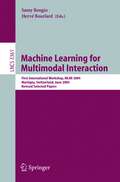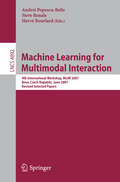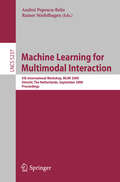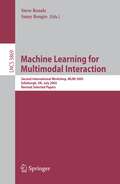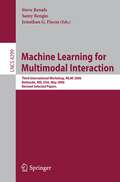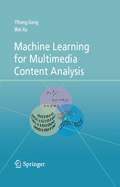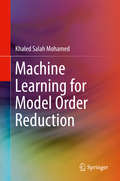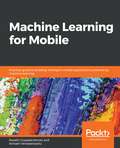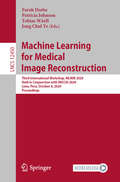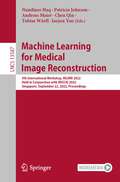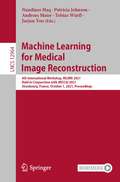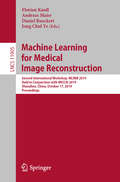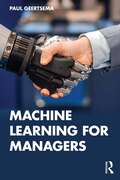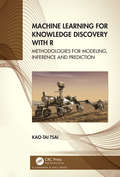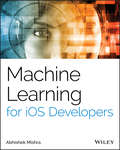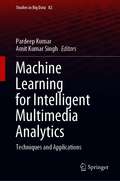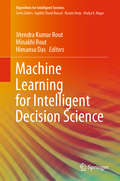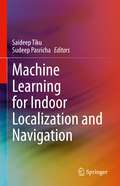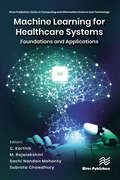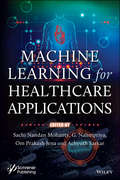- Table View
- List View
Machine Learning for Multimodal Interaction: First International Workshop, MLMI 2004, Martigny, Switzerland, June 21-23, 2004, Revised Selected Papers (Lecture Notes in Computer Science #3361)
by Samy Bengio Hervé BourlardMachine Learning for Multimodal Interaction: 4th International Workshop, MLMI 2007, Brno, Czech Republic, June 28-30, 2007, Revised Selected Papers (Lecture Notes in Computer Science #4892)
by Andrei Popescu-Belis Steve Renals Hervé BourlardMachine Learning for Multimodal Interaction: 5th International Workshop, MLMI 2008, Utrecht, The Netherlands, September 8-10, 2008, Proceedings (Lecture Notes in Computer Science #5237)
by Andrei Popescu-Belis Rainer StiefelhagenThis book constitutes the refereed proceedings of the 5th International Workshop on Machine Learning for Multimodal Interaction, MLMI 2008, held in Utrecht, The Netherlands, in September 2008. The 12 revised full papers and 15 revised poster papers presented together with 5 papers of a special session on user requirements and evaluation of multimodal meeting browsers/assistants were carefully reviewed and selected from 47 submissions. The papers cover a wide range of topics related to human-human communication modeling and processing, as well as to human-computer interaction, using several communication modalities. Special focus is given to the analysis of non-verbal communication cues and social signal processing, the analysis of communicative content, audio-visual scene analysis, speech processing, interactive systems and applications.
Machine Learning for Multimodal Interaction: Second International Workshop, MLMI 2005, Edinburgh, UK, July 11-13, 2005, Revised Selected Papers (Lecture Notes in Computer Science #3869)
by Steve Renals Samy BengioThis book constitutes the thoroughly refereed post-proceedings of the Second International Workshop on Machine Learning for Multimodal Interaction held in July 2005. The 38 revised full papers presented together with two invited papers were carefully selected during two rounds of reviewing and revision. The papers are organized in topical sections on multimodal processing, HCI and applications, discourse and dialogue, emotion, visual processing, speech and audio processing, and NIST meeting recognition evaluation.
Machine Learning for Multimodal Interaction: Third International Workshop, MLMI 2006, Bethesda, MD, USA, May 1-4, 2006, Revised Selected Papers (Lecture Notes in Computer Science #4299)
by Steve Renals Samy Bengio Jonathan FiskusThis book constitutes the thoroughly refereed post-proceedings of the Third International Workshop on Machine Learning for Multimodal Interaction, MLMI 2006, held in Bethesda, MD, USA, in May 2006. The papers are organized in topical sections on multimodal processing, image and video processing, HCI and applications, discourse and dialogue, speech and audio processing, and NIST meeting recognition evaluation.
Machine Learning for Multimedia Content Analysis (Multimedia Systems and Applications #30)
by Yihong Gong Wei XuThis volume introduces machine learning techniques that are particularly powerful and effective for modeling multimedia data and common tasks of multimedia content analysis. It systematically covers key machine learning techniques in an intuitive fashion and demonstrates their applications through case studies. Coverage includes examples of unsupervised learning, generative models and discriminative models. In addition, the book examines Maximum Margin Markov (M3) networks, which strive to combine the advantages of both the graphical models and Support Vector Machines (SVM).
Machine Learning for Model Order Reduction
by Khaled Salah MohamedThis Book discusses machine learning for model order reduction, which can be used in modern VLSI design to predict the behavior of an electronic circuit, via mathematical models that predict behavior. The author describes techniques to reduce significantly the time required for simulations involving large-scale ordinary differential equations, which sometimes take several days or even weeks. This method is called model order reduction (MOR), which reduces the complexity of the original large system and generates a reduced-order model (ROM) to represent the original one. Readers will gain in-depth knowledge of machine learning and model order reduction concepts, the tradeoffs involved with using various algorithms, and how to apply the techniques presented to circuit simulations and numerical analysis.Introduces machine learning algorithms at the architecture level and the algorithm levels of abstraction;Describes new, hybrid solutions for model order reduction;Presents machine learning algorithms in depth, but simply;Uses real, industrial applications to verify algorithms.
Machine Learning for Mobile: Practical Guide To Building Intelligent Mobile Applications Powered By Machine Learning
by Revathi GopalakrishnanLeverage the power of machine learning on mobile and build intelligent mobile applications with ease
Machine Learning for Medical Image Reconstruction: Third International Workshop, MLMIR 2020, Held in Conjunction with MICCAI 2020, Lima, Peru, October 8, 2020, Proceedings (Lecture Notes in Computer Science #12450)
by Farah Deeba Patricia Johnson Tobias Würfl Jong Chul YeThis book constitutes the refereed proceedings of the Third International Workshop on Machine Learning for Medical Reconstruction, MLMIR 2020, held in conjunction with MICCAI 2020, in Lima, Peru, in October 2020. The workshop was held virtually. The 15 papers presented were carefully reviewed and selected from 18 submissions. The papers are organized in the following topical sections: deep learning for magnetic resonance imaging and deep learning for general image reconstruction.
Machine Learning for Medical Image Reconstruction: 5th International Workshop, MLMIR 2022, Held in Conjunction with MICCAI 2022, Singapore, September 22, 2022, Proceedings (Lecture Notes in Computer Science #13587)
by Nandinee Haq Patricia Johnson Andreas Maier Chen Qin Tobias Würfl Jaejun YooThis book constitutes the refereed proceedings of the 5th International Workshop on Machine Learning for Medical Reconstruction, MLMIR 2022, held in conjunction with MICCAI 2022, in September 2022, held in Singapore.The 15 papers presented were carefully reviewed and selected from 19 submissions. The papers are organized in the following topical sections: deep learning for magnetic resonance imaging and deep learning for general image reconstruction.
Machine Learning for Medical Image Reconstruction: 4th International Workshop, MLMIR 2021, Held in Conjunction with MICCAI 2021, Strasbourg, France, October 1, 2021, Proceedings (Lecture Notes in Computer Science #12964)
by Nandinee Haq Patricia Johnson Andreas Maier Tobias Würfl Jaejun YooThis book constitutes the refereed proceedings of the 4th International Workshop on Machine Learning for Medical Reconstruction, MLMIR 2021, held in conjunction with MICCAI 2021, in October 2021. The workshop was planned to take place in Strasbourg, France, but was held virtually due to the COVID-19 pandemic. The 13 papers presented were carefully reviewed and selected from 20 submissions. The papers are organized in the following topical sections: deep learning for magnetic resonance imaging and deep learning for general image reconstruction.
Machine Learning for Medical Image Reconstruction: Second International Workshop, MLMIR 2019, Held in Conjunction with MICCAI 2019, Shenzhen, China, October 17, 2019, Proceedings (Lecture Notes in Computer Science #11905)
by Florian Knoll Andreas Maier Daniel Rueckert Jong Chul YeThis book constitutes the refereed proceedings of the Second International Workshop on Machine Learning for Medical Reconstruction, MLMIR 2019, held in conjunction with MICCAI 2019, in Shenzhen, China, in October 2019. The 24 full papers presented were carefully reviewed and selected from 32 submissions. The papers are organized in the following topical sections: deep learning for magnetic resonance imaging; deep learning for computed tomography; and deep learning for general image reconstruction.
Machine Learning for Managers
by Paul GeertsemaMachine learning can help managers make better predictions, automate complex tasks and improve business operations. Managers who are familiar with machine learning are better placed to navigate the increasingly digital world we live in. There is a view that machine learning is a highly technical subject that can only be understood by specialists. However, many of the ideas that underpin machine learning are straightforward and accessible to anyone with a bit of curiosity. This book is for managers who want to understand what machine learning is about, but who lack a technical background in computer science, statistics or math. The book describes in plain language what machine learning is and how it works. In addition, it explains how to manage machine learning projects within an organization. This book should appeal to anyone that wants to learn more about using machine learning to drive value in real-world organizations.
Machine Learning for Managers
by Paul GeertsemaMachine learning can help managers make better predictions, automate complex tasks and improve business operations. Managers who are familiar with machine learning are better placed to navigate the increasingly digital world we live in. There is a view that machine learning is a highly technical subject that can only be understood by specialists. However, many of the ideas that underpin machine learning are straightforward and accessible to anyone with a bit of curiosity. This book is for managers who want to understand what machine learning is about, but who lack a technical background in computer science, statistics or math. The book describes in plain language what machine learning is and how it works. In addition, it explains how to manage machine learning projects within an organization. This book should appeal to anyone that wants to learn more about using machine learning to drive value in real-world organizations.
Machine Learning for Knowledge Discovery with R: Methodologies for Modeling, Inference and Prediction
by Kao-Tai TsaiMachine Learning for Knowledge Discovery with R contains methodologies and examples for statistical modelling, inference, and prediction of data analysis. It includes many recent supervised and unsupervised machine learning methodologies such as recursive partitioning modelling, regularized regression, support vector machine, neural network, clustering, and causal-effect inference. Additionally, it emphasizes statistical thinking of data analysis, use of statistical graphs for data structure exploration, and result presentations. The book includes many real-world data examples from life-science, finance, etc. to illustrate the applications of the methods described therein. Key Features: Contains statistical theory for the most recent supervised and unsupervised machine learning methodologies. Emphasizes broad statistical thinking, judgment, graphical methods, and collaboration with subject-matter-experts in analysis, interpretation, and presentations. Written by statistical data analysis practitioner for practitioners. The book is suitable for upper-level-undergraduate or graduate-level data analysis course. It also serves as a useful desk-reference for data analysts in scientific research or industrial applications.
Machine Learning for Knowledge Discovery with R: Methodologies for Modeling, Inference and Prediction
by Kao-Tai TsaiMachine Learning for Knowledge Discovery with R contains methodologies and examples for statistical modelling, inference, and prediction of data analysis. It includes many recent supervised and unsupervised machine learning methodologies such as recursive partitioning modelling, regularized regression, support vector machine, neural network, clustering, and causal-effect inference. Additionally, it emphasizes statistical thinking of data analysis, use of statistical graphs for data structure exploration, and result presentations. The book includes many real-world data examples from life-science, finance, etc. to illustrate the applications of the methods described therein. Key Features: Contains statistical theory for the most recent supervised and unsupervised machine learning methodologies. Emphasizes broad statistical thinking, judgment, graphical methods, and collaboration with subject-matter-experts in analysis, interpretation, and presentations. Written by statistical data analysis practitioner for practitioners. The book is suitable for upper-level-undergraduate or graduate-level data analysis course. It also serves as a useful desk-reference for data analysts in scientific research or industrial applications.
Machine Learning for iOS Developers
by Abhishek MishraHarness the power of Apple iOS machine learning (ML) capabilities and learn the concepts and techniques necessary to be a successful Apple iOS machine learning practitioner! Machine earning (ML) is the science of getting computers to act without being explicitly programmed. A branch of Artificial Intelligence (AI), machine learning techniques offer ways to identify trends, forecast behavior, and make recommendations. The Apple iOS Software Development Kit (SDK) allows developers to integrate ML services, such as speech recognition and language translation, into mobile devices, most of which can be used in multi-cloud settings. Focusing on Apple’s ML services, Machine Learning for iOS Developers is an up-to-date introduction to the field, instructing readers to implement machine learning in iOS applications. Assuming no prior experience with machine learning, this reader-friendly guide offers expert instruction and practical examples of ML integration in iOS. Organized into two sections, the book’s clearly-written chapters first cover fundamental ML concepts, the different types of ML systems, their practical uses, and the potential challenges of ML solutions. The second section teaches readers to use models—both pre-trained and user-built—with Apple’s CoreML framework. Source code examples are provided for readers to download and use in their own projects. This book helps readers: Understand the theoretical concepts and practical applications of machine learning used in predictive data analytics Build, deploy, and maintain ML systems for tasks such as model validation, optimization, scalability, and real-time streaming Develop skills in data acquisition and modeling, classification, and regression. Compare traditional vs. ML approaches, and machine learning on handsets vs. machine learning as a service (MLaaS) Implement decision tree based models, an instance-based machine learning system, and integrate Scikit-learn & Keras models with CoreML Machine Learning for iOS Developers is a must-have resource software engineers and mobile solutions architects wishing to learn ML concepts and implement machine learning on iOS Apps.
Machine Learning for iOS Developers
by Abhishek MishraHarness the power of Apple iOS machine learning (ML) capabilities and learn the concepts and techniques necessary to be a successful Apple iOS machine learning practitioner! Machine earning (ML) is the science of getting computers to act without being explicitly programmed. A branch of Artificial Intelligence (AI), machine learning techniques offer ways to identify trends, forecast behavior, and make recommendations. The Apple iOS Software Development Kit (SDK) allows developers to integrate ML services, such as speech recognition and language translation, into mobile devices, most of which can be used in multi-cloud settings. Focusing on Apple’s ML services, Machine Learning for iOS Developers is an up-to-date introduction to the field, instructing readers to implement machine learning in iOS applications. Assuming no prior experience with machine learning, this reader-friendly guide offers expert instruction and practical examples of ML integration in iOS. Organized into two sections, the book’s clearly-written chapters first cover fundamental ML concepts, the different types of ML systems, their practical uses, and the potential challenges of ML solutions. The second section teaches readers to use models—both pre-trained and user-built—with Apple’s CoreML framework. Source code examples are provided for readers to download and use in their own projects. This book helps readers: Understand the theoretical concepts and practical applications of machine learning used in predictive data analytics Build, deploy, and maintain ML systems for tasks such as model validation, optimization, scalability, and real-time streaming Develop skills in data acquisition and modeling, classification, and regression. Compare traditional vs. ML approaches, and machine learning on handsets vs. machine learning as a service (MLaaS) Implement decision tree based models, an instance-based machine learning system, and integrate Scikit-learn & Keras models with CoreML Machine Learning for iOS Developers is a must-have resource software engineers and mobile solutions architects wishing to learn ML concepts and implement machine learning on iOS Apps.
Machine Learning for Intelligent Multimedia Analytics: Techniques and Applications (Studies in Big Data #82)
by Pardeep Kumar Amit Kumar SinghThis book presents applications of machine learning techniques in processing multimedia large-scale data. Multimedia such as text, image, audio, video, and graphics stands as one of the most demanding and exciting aspects of the information era. The book discusses new challenges faced by researchers in dealing with these large-scale data and also presents innovative solutions to address several potential research problems, e.g., enabling comprehensive visual classification to fill the semantic gap by exploring large-scale data, offering a promising frontier for detailed multimedia understanding, as well as extract patterns and making effective decisions by analyzing the large collection of data.
Machine Learning for Intelligent Decision Science (Algorithms for Intelligent Systems)
by Jitendra Kumar Rout Minakhi Rout Himansu DasThe book discusses machine learning-based decision-making models, and presents intelligent, hybrid and adaptive methods and tools for solving complex learning and decision-making problems under conditions of uncertainty. Featuring contributions from data scientists, practitioners and educators, the book covers a range of topics relating to intelligent systems for decision science, and examines recent innovations, trends, and practical challenges in the field. The book is a valuable resource for academics, students, researchers and professionals wanting to gain insights into decision-making.
Machine Learning for Indoor Localization and Navigation
by Saideep Tiku Sudeep PasrichaWhile GPS is the de-facto solution for outdoor positioning with a clear sky view, there is no prevailing technology for GPS-deprived areas, including dense city centers, urban canyons, buildings and other covered structures, and subterranean facilities such as underground mines, where GPS signals are severely attenuated or totally blocked. As an alternative to GPS for the outdoors, indoor localization using machine learning is an emerging embedded and Internet of Things (IoT) application domain that is poised to reinvent the way we navigate in various indoor environments. This book discusses advances in the applications of machine learning that enable the localization and navigation of humans, robots, and vehicles in GPS-deficient environments. The book explores key challenges in the domain, such as mobile device resource limitations, device heterogeneity, environmental uncertainties, wireless signal variations, and security vulnerabilities. Countering these challenges can improve the accuracy, reliability, predictability, and energy-efficiency of indoor localization and navigation. The book identifies severalnovel energy-efficient, real-time, and robust indoor localization techniques that utilize emerging deep machine learning and statistical techniques to address the challenges for indoor localization and navigation. In particular, the book:Provides comprehensive coverage of the application of machine learning to the domain of indoor localization;Presents techniques to adapt and optimize machine learning models for fast, energy-efficient indoor localization;Covers design and deployment of indoor localization frameworks on mobile, IoT, and embedded devices in real conditions.
Machine Learning for Imbalanced Data: Tackle imbalanced datasets using machine learning and deep learning techniques
by Kumar Abhishek Dr. Mounir AbdelazizTake your machine learning expertise to the next level with this essential guide, utilizing libraries like imbalanced-learn, PyTorch, scikit-learn, pandas, and NumPy to maximize model performance and tackle imbalanced dataKey FeaturesUnderstand how to use modern machine learning frameworks with detailed explanations, illustrations, and code samplesLearn cutting-edge deep learning techniques to overcome data imbalanceExplore different methods for dealing with skewed data in ML and DL applicationsPurchase of the print or Kindle book includes a free eBook in the PDF formatBook DescriptionAs machine learning practitioners, we often encounter imbalanced datasets in which one class has considerably fewer instances than the other. Many machine learning algorithms assume an equilibrium between majority and minority classes, leading to suboptimal performance on imbalanced data. This comprehensive guide helps you address this class imbalance to significantly improve model performance. Machine Learning for Imbalanced Data begins by introducing you to the challenges posed by imbalanced datasets and the importance of addressing these issues. It then guides you through techniques that enhance the performance of classical machine learning models when using imbalanced data, including various sampling and cost-sensitive learning methods. As you progress, you’ll delve into similar and more advanced techniques for deep learning models, employing PyTorch as the primary framework. Throughout the book, hands-on examples will provide working and reproducible code that’ll demonstrate the practical implementation of each technique. By the end of this book, you’ll be adept at identifying and addressing class imbalances and confidently applying various techniques, including sampling, cost-sensitive techniques, and threshold adjustment, while using traditional machine learning or deep learning models.What you will learnUse imbalanced data in your machine learning models effectivelyExplore the metrics used when classes are imbalancedUnderstand how and when to apply various sampling methods such as over-sampling and under-samplingApply data-based, algorithm-based, and hybrid approaches to deal with class imbalanceCombine and choose from various options for data balancing while avoiding common pitfallsUnderstand the concepts of model calibration and threshold adjustment in the context of dealing with imbalanced datasetsWho this book is forThis book is for machine learning practitioners who want to effectively address the challenges of imbalanced datasets in their projects. Data scientists, machine learning engineers/scientists, research scientists/engineers, and data scientists/engineers will find this book helpful. Though complete beginners are welcome to read this book, some familiarity with core machine learning concepts will help readers maximize the benefits and insights gained from this comprehensive resource.
Machine Learning for Healthcare Systems: Foundations and Applications (River Publishers Series in Computing and Information Science and Technology)
by C. Karthik Chandran M. Rajalakshmi Sachi Nandan Mohanty Subrata ChowdhuryThe introduction of digital technology in the healthcare industry is marked by ongoing difficulties with implementation and use. Slow progress has been made in unifying different healthcare systems, and much of the world still lacks a fully integrated healthcare system. The intrinsic complexity and development of human biology, as well as the differences across patients, have repeatedly demonstrated the significance of the human element in the diagnosis and treatment of illnesses. But as digital technology develops, healthcare providers will undoubtedly need to use it more and more to give patients the best treatment possible. The extensive use of machine learning in numerous industries, including healthcare, has been made possible by advancements in data technologies, including storage capacity, processing capability, and data transit speeds. The need for a personalized medicine or "precision medicine" approach to healthcare has been highlighted by current trends in medicine due to the complexity of providing effective healthcare to each individual. Personalized medicine aims to identify, forecast, and analyze diagnostic decisions using vast volumes of healthcare data so that doctors may then apply them to each unique patient. These data may include, but are not limited to, information on a person’s genes or family history, medical imaging data, drug combinations, patient health outcomes at the community level, and natural language processing of pre-existing medical documentation. This book provides various insights into machine learning techniques in healthcare system data and its analysis. Recent technological advancements in the healthcare system represent cutting-edge innovations and global research successes in performance modelling, analysis, and applications.
Machine Learning for Healthcare Systems: Foundations and Applications (River Publishers Series in Computing and Information Science and Technology)
by C. Karthik M. Rajalakshmi Sachi Nandan Mohanty Subrata ChowdhuryThe introduction of digital technology in the healthcare industry is marked by ongoing difficulties with implementation and use. Slow progress has been made in unifying different healthcare systems, and much of the world still lacks a fully integrated healthcare system. The intrinsic complexity and development of human biology, as well as the differences across patients, have repeatedly demonstrated the significance of the human element in the diagnosis and treatment of illnesses. But as digital technology develops, healthcare providers will undoubtedly need to use it more and more to give patients the best treatment possible. The extensive use of machine learning in numerous industries, including healthcare, has been made possible by advancements in data technologies, including storage capacity, processing capability, and data transit speeds. The need for a personalized medicine or "precision medicine" approach to healthcare has been highlighted by current trends in medicine due to the complexity of providing effective healthcare to each individual. Personalized medicine aims to identify, forecast, and analyze diagnostic decisions using vast volumes of healthcare data so that doctors may then apply them to each unique patient. These data may include, but are not limited to, information on a person’s genes or family history, medical imaging data, drug combinations, patient health outcomes at the community level, and natural language processing of pre-existing medical documentation. This book provides various insights into machine learning techniques in healthcare system data and its analysis. Recent technological advancements in the healthcare system represent cutting-edge innovations and global research successes in performance modelling, analysis, and applications.
Machine Learning for Healthcare Applications
by Sachi Nandan Mohanty G. Nalinipriya Om Prakash Jena Achyuth SarkarWhen considering the idea of using machine learning in healthcare, it is a Herculean task to present the entire gamut of information in the field of intelligent systems. It is, therefore the objective of this book to keep the presentation narrow and intensive. This approach is distinct from others in that it presents detailed computer simulations for all models presented with explanations of the program code. It includes unique and distinctive chapters on disease diagnosis, telemedicine, medical imaging, smart health monitoring, social media healthcare, and machine learning for COVID-19. These chapters help develop a clear understanding of the working of an algorithm while strengthening logical thinking. In this environment, answering a single question may require accessing several data sources and calling on sophisticated analysis tools. While data integration is a dynamic research area in the database community, the specific needs of research have led to the development of numerous middleware systems that provide seamless data access in a result-driven environment. Since this book is intended to be useful to a wide audience, students, researchers and scientists from both academia and industry may all benefit from this material. It contains a comprehensive description of issues for healthcare data management and an overview of existing systems, making it appropriate for introductory and instructional purposes. Prerequisites are minimal; the readers are expected to have basic knowledge of machine learning. This book is divided into 22 real-time innovative chapters which provide a variety of application examples in different domains. These chapters illustrate why traditional approaches often fail to meet customers’ needs. The presented approaches provide a comprehensive overview of current technology. Each of these chapters, which are written by the main inventors of the presented systems, specifies requirements and provides a description of both the chosen approach and its implementation. Because of the self-contained nature of these chapters, they may be read in any order. Each of the chapters use various technical terms which involve expertise in machine learning and computer science.
